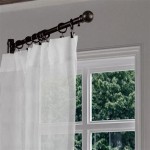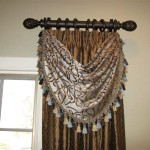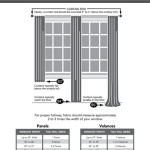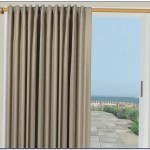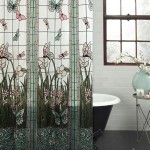Pattern Curtains For Living Room: A Comprehensive Guide
Patterned curtains represent a versatile design element capable of transforming a living room's aesthetic. They offer a means to introduce color, texture, and personality, serving as more than mere window coverings. Selecting the right pattern requires careful consideration of the existing décor, the desired ambiance, and the functionality of the space.
The impact of patterned curtains extends beyond visual appeal. They can influence the perceived size and shape of a room, affect the amount of natural light entering the space, and contribute to the overall sound absorption. Therefore, a thorough understanding of the various pattern types, fabric choices, and styling options is crucial for achieving a harmonious and functional living room design.
Understanding Pattern Types and Their Impact
Patterned curtains encompass a vast array of designs, each with its own distinct characteristics and potential impact. Floral patterns, geometric designs, abstract motifs, and novelty prints are just a few examples. The choice of pattern should align with the existing style of the living room and the desired atmosphere.
Floral patterns tend to evoke a sense of romance, femininity, and natural beauty. They can range from delicate, small-scale prints to bold, oversized blooms. Smaller floral patterns are generally suitable for smaller living rooms, as they avoid overwhelming the space. Larger floral patterns can create a dramatic and impactful statement in larger living rooms, provided the surrounding décor is relatively simple.
Geometric patterns offer a more structured and contemporary aesthetic. They can include stripes, chevrons, polka dots, and more complex tessellations. Geometric patterns can add a sense of order and visual interest, particularly in minimalist or modern living rooms. Horizontal stripes can visually widen a room, while vertical stripes can create the illusion of height. The scale of the geometric pattern should be proportionate to the size of the room; larger patterns can be overwhelming in smaller spaces.
Abstract motifs provide a more artistic and unconventional approach. They can incorporate a range of shapes, colors, and textures, allowing for greater creative expression. Abstract patterns are well-suited for eclectic or bohemian living rooms, where a sense of individuality and artistic flair is desired. The specific colors and textures within the abstract pattern should complement the existing color palette and materials in the room.
Novelty prints feature thematic or whimsical designs, often incorporating animals, objects, or scenes. These patterns can add a touch of personality and playfulness to a living room. However, novelty prints should be used judiciously, as they can easily become overwhelming or clash with the overall style. They are generally more appropriate for informal living rooms or children's play areas.
The scale of the pattern is a critical consideration. Large-scale patterns can make a small room feel even smaller, while small-scale patterns can be lost in a large room. Repetitive patterns can also impact the overall feel of the room. A densely repeated pattern can feel busy and overwhelming, while a more sparsely repeated pattern can feel calmer and more relaxing.
Fabric Selection and Its Role in Pattern Display
The fabric of patterned curtains significantly influences how the pattern is displayed and its overall effect on the room. Different fabrics have varying textures, weights, and drapes, each contributing to the final visual impact.
Linen is a natural fiber known for its breathability and relaxed, slightly textured appearance. Linen curtains offer a casual and airy feel, making them well-suited for bohemian or coastal-style living rooms. The texture of linen can soften the edges of a geometric pattern or add depth to a floral print. However, linen is prone to wrinkling, which may require occasional ironing or steaming.
Cotton is another natural fiber, known for its versatility and affordability. Cotton curtains are available in a wide range of weights and weaves, making them suitable for various styles. Cotton drapes well and is relatively easy to care for. It can effectively display a variety of patterns, from delicate florals to bold geometrics. However, cotton can fade over time when exposed to direct sunlight, so it may be necessary to use a lining or choose a fabric with UV protection.
Velvet is a luxurious fabric with a soft, plush texture. Velvet curtains add a sense of opulence and drama to a living room. The dense pile of velvet can enhance the richness and depth of colors, making it an excellent choice for showcasing intricate patterns. Velvet also provides excellent sound absorption and light blocking, making it ideal for creating a cozy and intimate atmosphere. However, velvet can be heavy and may require professional cleaning.
Polyester is a synthetic fabric known for its durability and resistance to wrinkles and fading. Polyester curtains are a practical choice for high-traffic areas or rooms that receive a lot of sunlight. They are available in a wide range of colors and patterns and are relatively easy to care for. Polyester can effectively mimic the look of natural fibers, such as linen or silk, at a more affordable price point.
The choice of lining also affects the display of the pattern. Blackout linings can completely block out light, creating a dark and private space. Thermal linings can help insulate the room, reducing energy costs. Decorative linings can add a touch of elegance and sophistication. The color of the lining can also influence the color of the pattern, so it's important to consider the overall effect when making a selection.
Styling Options and Complementary Decor Elements
The way patterned curtains are styled can significantly impact their visual appeal and their integration into the overall living room design. Considerations include curtain length, hanging style, hardware selection, and complementary décor elements.
Curtain length can dramatically alter the perceived height and proportion of a room. Curtains that graze the floor create a polished and elegant look. Curtains that puddle slightly on the floor add a touch of romance and drama. Curtains that are too short can make a room feel unfinished or awkward. The optimal curtain length depends on the ceiling height and the desired aesthetic.
The hanging style also plays a crucial role. Rod pocket curtains create a classic and traditional look. Grommet curtains offer a more modern and streamlined appearance. Tab top curtains provide a casual and relaxed feel. Pleated curtains add a touch of formality and sophistication. The choice of hanging style should complement the style of the pattern and the overall décor of the living room.
Hardware selection, including the curtain rod and finials, can further enhance the style of the curtains. Metal rods offer a sleek and modern look, while wooden rods provide a more traditional and warm aesthetic. Finials can add a decorative touch and complement the pattern of the curtains. The color and finish of the hardware should coordinate with the other metal accents in the room.
Complementary décor elements, such as throw pillows, rugs, and wall art, can help tie the patterned curtains into the overall living room design. Choosing colors and patterns that echo or complement the curtains creates a cohesive and harmonious look. For example, if the curtains feature a floral pattern, incorporating throw pillows with similar floral motifs can reinforce the theme. A rug with geometric patterns can complement geometric curtains, adding depth and visual interest.
The color palette of the living room should also be considered when selecting patterned curtains. Choosing colors that complement the existing walls, furniture, and accessories will create a more harmonious and balanced space. Neutral-colored walls provide a versatile backdrop for showcasing bold and colorful patterns. Conversely, patterned walls may call for more subtle and understated curtains. The key is to create a sense of visual balance and avoid overwhelming the space with too many competing patterns or colors.
Finally, consider the amount of natural light in the living room. If the room receives a lot of sunlight, choose lighter-colored fabrics that won't fade easily. If the room is darker, consider using brighter colors to brighten the space. Lined curtains can also help control the amount of light that enters the room, providing privacy and reducing glare.

Blue Geometric Pattern Curtains Drapes For Bedroom Anady Top

How To Style Curtains For Living Rooms Blinds Direct Blog

Decorating With Patterns 10 Game Changing Tips For Your Home

Made To Measure Patterned Curtains Up 50 Off Hillarys

20 Curtain Ideas For Your Home The

Living Room Curtain Designs For Every Style

Discover The Best Pattern Curtains For Your Living Room A Guide Dolcewe

Made To Measure Living Room Curtains

How To Choose The Right Curtains Shade

Boho Curtains For Living Room Mudcloth Pattern Blackout Bedroom Minimalist Modern Bohemian Black White Sheer Etsy


